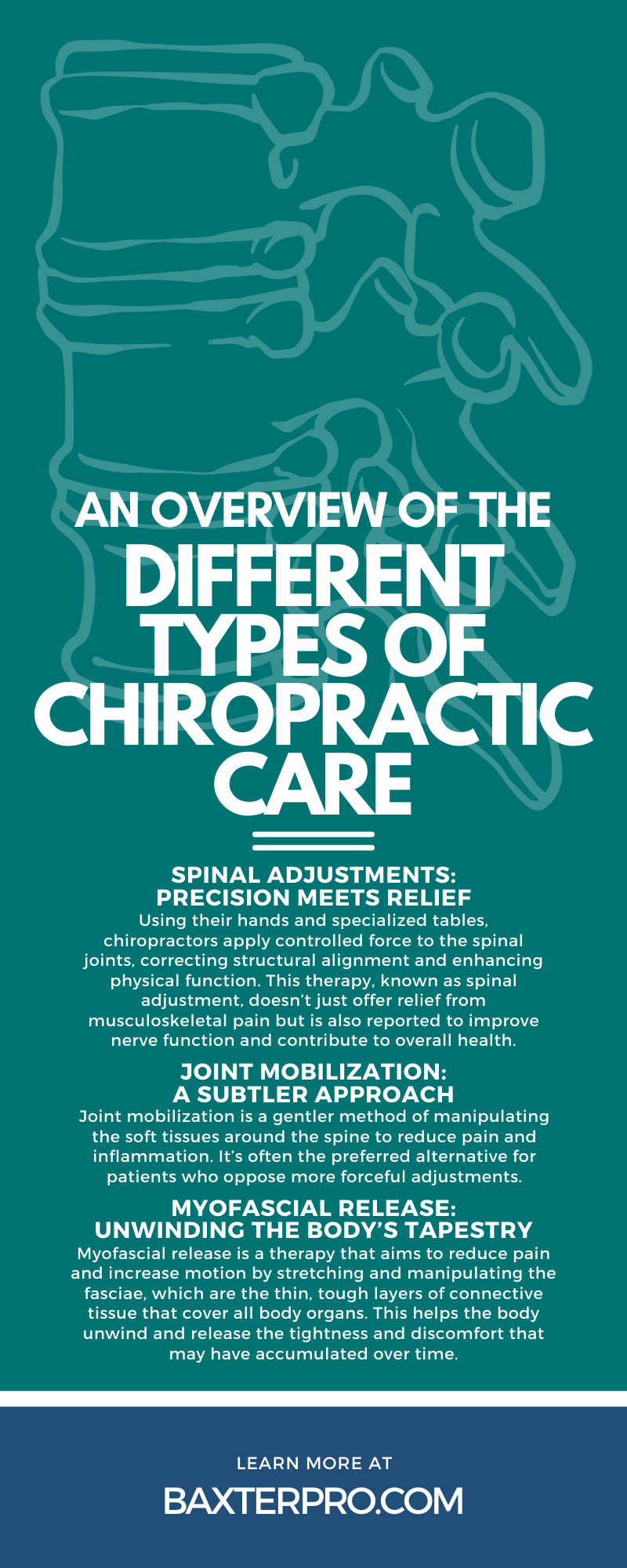In their pursuits of holistic health and wellness, more individuals are turning to chiropractic care. This branch of alternative medicine focuses on the diagnosis and manipulative treatment of misalignments of the joints, which are believed to cause other disorders by affecting the nerves, muscles, and organs. Whether you’re a chiropractor considering what type of treatment to specialize in, a student considering a chiropractic career, or just someone who wants to learn more about chiropractic care, we’ll take you through an overview of the many different types of care below.
The Backbone of Chiropractic Care: Manual Manipulation Techniques
The foundations of chiropractic care are built upon manually manipulating the spine and other joints. Known for centuries as an artful technique, these hands-on methods form the cornerstones of the profession and are often closely associated with the “cracking” sound that signals joint movement.
Spinal Adjustments: Precision Meets Relief
Using their hands and specialized tables, chiropractors apply controlled force to the spinal joints, correcting structural alignment and enhancing physical function. This therapy, known as spinal adjustment, doesn’t just offer relief from musculoskeletal pain but is also reported to improve nerve function and contribute to overall health.
Joint Mobilization: A Subtler Approach
Joint mobilization is a gentler method of manipulating the soft tissues around the spine to reduce pain and inflammation. It’s often the preferred alternative for patients who oppose more forceful adjustments.
Instrument-Assisted Techniques: Precision in Practice
As technology has advanced, so have the tools at a chiropractor’s disposal. Instrument-assisted techniques provide a nuanced, targeted approach to treatment, which is particularly beneficial for patients who need more delicate care or for very specific areas that may be harder to manipulate by hand.
The Activator Method: A Swift Activation
The activator method employs a small, handheld instrument known as an activator adjusting instrument, which delivers controlled, rapid force to restore motion to a joint. This method is known for being highly effective, precise, and low-force, making it an excellent choice for more sensitive patients.
Impulse Adjusting: Powerful Yet Precise
Impulse adjusting uses a high-tech handheld device that applies controlled force to the body, particularly the spine, to improve motion, correct misalignments, reduce pain, and relieve muscle tension. It’s effective, gentle, and often preferred by seasoned chiropractic patients who appreciate the comfort of a tool-assisted approach.
Soft-Tissue Techniques: A Balancing Act
Chiropractic care can extend beyond the skeletal system to address the complex network of soft tissues, predominantly muscles and connective tissues. Soft-tissue techniques not only complement other chiropractic methods but also provide stand-alone benefits for a variety of musculoskeletal issues.
Myofascial Release: Unwinding the Body’s Tapestry
Myofascial release is a therapy that aims to reduce pain and increase motion by stretching and manipulating the fasciae, which are the thin, tough layers of connective tissue that cover all body organs. This helps the body unwind and release the tightness and discomfort that may have accumulated over time.
Trigger Point Therapy: Pinpointing Pain Relief
Trigger points, or muscle “knots,” are areas within the muscle that can induce pain in seemingly unrelated body parts. Trigger point therapy involves applying pressure to these points to alleviate the pain and restore normal function to the muscle.
Tailored Treatments: Specialized Chiropractic Care
Chiropractic services are not one-size-fits-all, and this is especially true for specialized populations. Chiropractors train in specific techniques to care for individuals beyond the standard adult patient, from the youngest to the most active.
For instance, athletes push their bodies to the limit, making them susceptible to injuries and imbalances. Sports chiropractic care focuses on the special needs of physically active people, aiming to improve performance and prevent injuries through specialized adjustments and exercise regimens tailored to each sport’s demands.
A Cohesive Strategy: Complementary Therapies
The strength of chiropractic care lies in its holistic approach to health and its willingness to collaborate with other forms of therapy. These complementary treatments can enhance the effects of chiropractic care, promoting an environment in which the body can heal itself.
Massage Therapy: A Soothing Synergy
The synergy between chiropractic care and massage therapy is well-known. Chiropractic adjustments focus on realigning the body’s structure, while massage therapy complements them by addressing the muscles and soft tissues. This cooperative approach often leads to quicker recovery and a more comfortable patient experience.
Acupuncture: A Fusion of Traditions
The insertion of fine needles into specific points on the body is thought to restore balance to the body’s energy flow. When incorporated into chiropractic care, acupuncture can enhance the effectiveness of chiropractic adjustments, providing patients with a combined approach to pain management, stress reduction, and healing.
Unlocking Wellness: Why Explore Different Types of Chiropractic Care?
Each patient brings unique circumstances and health goals to the chiropractor’s table. By exploring different types of chiropractic care, individuals can find the right combination of techniques that resonate with their needs, preferences, and comfort levels.
The human body is like a complex puzzle, each piece interconnected and contributing to the whole. Chiropractic care offers a personalized approach to health and wellness, recognizing that no two patients are the same. By exploring diverse treatment options, patients can find the pieces that fit together to create a complete picture of well-being.
Continuous Improvement: Embracing Evolution in Health Care
The health-care field constantly evolves, with new research and insight leading to better, more effective treatments. Chiropractic care is no exception. Chiropractors who embrace various techniques and stay updated on the latest developments are better equipped to serve their patients with the highest level of care.
The breadth and depth of chiropractic care are vast, offering many techniques and methods to address various health concerns. From traditional manual adjustments to modern instrument-assisted treatments, our overview has covered many different types of chiropractic care and its place in promoting healing, enhancing function, and fostering wellness.
If you’re a practicing chiropractor, you need liability insurance. Baxter & Associates can help you find malpractice insurance for chiropractors that ensures you and your practice stay protected. Get a quote online, or contact our expert staff to learn more today.









